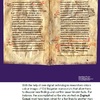VISIT TO THE MOBILE EXHIBITION "STORIES FROM VERBAL TIMES" AT THE MFA
Two alphabets were used in the Middle Ages in Europe: Latin (or Roman) and Greek. Those were the sacred alphabets of Christianity and all literature was written in Latin or Greek. In the late 9th century, that unwritten rule was broken once and for all. Bulgaria, one of the large states at the time that had recently converted to Christianity, started using two new scripts.
The Glagolitic alphabet was brought in by the disciples of its creators: Constantine Cyril and Methodius. Men of letters, teachers and translators were trained to use it and produced numerous translations eventually giving rise to what we now refer to as The Golden Age of Bulgarian Literature.
The Cyrillic alphabet created in Bulgaria in the late 9th century was inspired by Glagolitic. Cyrillic was taken up by writers of books and documents but was used also for everyday purposes. The two, Glagolitic and Cyrillic, coexisted in education and manuscripts in the course of two centuries before Cyrillic gained dominance. Yet even then the memory of and respect for the older alphabet did not fade.
The exhibition Stories of Glagolitic Times presents for the first time high- resolution images of medieval manuscripts that tell stories from Glagolitic times. They bear witness to the work of industrious scribes and the fate of invaluable texts. Those are stories distilled from the scarce evidence that has reached us thanks to the long arm of coincidence. It might be for that reason that they reveal the script in an unexpected light: not always bright, and oftentimes as the product of the writers’ strenuous effort to preserve the Word, the spirit and the faith amidst everyday vicissitudes and hardships unfathomable to people today
The exhibition can be seen on 7th floor in central building in Ministry of Foreign Аffairs.


